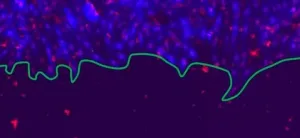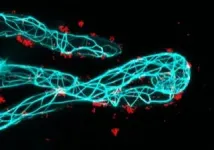(Press-News.org) In material physics understanding how systems interact across the interfaces separating them is of central interest. But can physical models clarify similar concepts in living systems, such as cells? Physicists at the University of Geneva (UNIGE), in collaboration with the University of Zurich (UZH), used the framework of disordered elastic systems to study the process of wound healing - the proliferation of cell fronts which eventually join to close a lesion. Their study identified the scales of the dominant interactions between cells which determine this process. The results, published in the journal Scientific Reports, will allow better analysis of cell front behaviour, in terms of both wound healing and tumour development. In the future, this approach may offer personalised diagnostics to classify cancers and better target their treatment, and identify new pharmacological targets for transplantation.
By focusing on macroscopic properties of large datasets, statistical physics makes it possible to extract an overview of system behaviour independent of its specific microscopic character. Applied to biological elements, such as the cell fronts bordering a wound, this approach makes it possible to identify the various interactions which play a defining role during tissue growth, differentiation, and healing, but above all to highlight their hierarchy at the different scales observed. Patrycja Paruch, professor in the Department of Quantum Matter Physics at the UNIGE Faculty of Science, explains: "For cancer tumour invasion, or in the event of a wound, cell front proliferation is crucial, but the speed and morphology of the front is highly variable. However, we believe that only a few dominant interactions during this process will define the dynamics and the shape - smooth or rough, for example - of the cell colony edge. Experimental observations across multiple lengthscales to extract general behaviours can allow us to identify these interactions in healthy tissue and diagnose at what level pathological changes can occur, to help combat them. This is where statistical physics comes in."
The many scales of wound healing
In this multidisciplinary study, the UNIGE physicists collaborated with the team of Professor Steven Brown from the UZH. Using rat epithelial cells, they established flat colonies (2D) in which the cells grow around a silicone insert, subsequently removed to mimic an open lesion. The cell fronts then proliferate to fill the opening and heal the tissue. "We reproduced five possible scenarios by 'handicapping' the cells in different ways, in order to see what impact this has on wound healing, i.e. on the speed and roughness of the cell front", explains Guillaume Rapin, a researcher in Patrycja Paruch's team. The idea is to see what happens in normal healthy tissue, or when processes such as cell division and communication between neighbouring cells are inhibited, when cell mobility is reduced or when cells are permanently pharmacologically stimulated. "We took some 300 images every four hours for about 80 hours, which allowed us to observe the proliferating cell fronts at very different scales", continues Guillaume Rapin. "By applying high-performance computational techniques, we were able to compare our experimental observations with the results of numerical simulations", adds Nirvana Caballero, another researcher in Patrycja Paruch's team.
Zooming out for greater effect
The scientists observed two distinct roughness regimes: at less than 15 micrometres, below the size of a single cell, and between 80 and 200 micrometres, when several cells are involved. "We have analysed how the roughness exponent evolves over time to reach its natural dynamic equilibrium, depending on the pharmacochemical conditions we have imposed on the cells, and how this roughness increases depending on the scale at which we look", emphasises Nirvana Caballero. "In a system with a single dominant interaction, we expect to see the same roughness exponent at all scales. Here, we see a changing roughness if we look at the scale of one cell or of ten cells."
The Geneva and Zurich teams revealed only minor variations in the roughness exponent below 15 micrometres, whatever the conditions imposed on the cell fronts. On the other hand, they found that between 80 and 150 micrometers, the roughness is altered by all pharmacological inhibitors, significantly reducing the roughness exponent. Moreover, they observed that proliferation speed varied greatly between the different pharmacochemical conditions, slowing when cell division and motility were inhibited, and accelerating when cells were stimulated. "More surprisingly, the fastest proliferation speed was achieved when gap-junction communication between cells was blocked", says Guillaume Rapin. This observation suggests that such communication may be targeted in future therapies, either to promote healing of burns or wounds, or to slow cancer tumour invasion.
These results show that medium-scale interactions play a crucial role in determining the healthy proliferation of a cell front. "We now know at what scale biologists should look for problematic behaviour of cell fronts, which can lead to the development of tumours", says Nirvana Caballero. Now scientists will be able to focus on these key lenghtscales to probe tumour cells fronts, and directly compare their pathological interactions with this of healthy cells.
INFORMATION:
Scientists are warning that drinking water supplies in parts of rural West Africa are being contaminated by lead-containing materials used in small community water systems such as boreholes with handpumps and public taps.
They analysed scrapings taken from the plumbing of 61 community water supply systems in Ghana, Mali and Niger. Eighty percent of the tested systems had at least one component that contained lead in excess of international guidance.
Lead is released into the water when the components corrode.
The study, by a research team from the University of Leeds, University of North Carolina at Chapel Hill and Boston University, also took samples of the water from those 61 water distribution systems, ...
Migratory waterbirds are particularly exposed to the effects of climate change at their breeding areas in the High Arctic and in Africa, according to a new study published in Bird Conservation International. The research team came to this conclusion after modelling climatic and hydrological conditions under current and future climate scenarios (in 2050) and comparing the impact on the distribution of 197 of the 255 waterbird species listed under the Agreement on the Conservation of African-Eurasian Migratory Waterbirds (AEWA). The international team was led by Wetlands International, BirdLife International, and the British Trust for Ornithology, involved researchers from various universities, including McGill. The results suggest that investing more in habitat conservation in the wider ...
A team of researchers led by Nanyang Technological University, Singapore (NTU Singapore) has developed a device that offers a quicker and less invasive way to seal tears and holes in blood vessels, using an electrically-activated glue patch applied via a minimally invasive balloon catheter.
This device could eventually replace the need for open or keyhole surgery to patch up or stitch together internal blood vessel defects.
After inserting the catheter into an appropriate blood vessel, the glue patch - nicknamed 'Voltaglue' - can be guided through the body to where the tear is located and then activated using retractable electrodes to glue it shut in ...
Symptoms of health anxiety are common already during childhood and adolescence - and if the children do not receive the correct help, the anxiety can become a permanent problem with serious personal and socio-economic consequences. This is shown by a new research result from Aarhus University and the University of Copenhagen.
Ida is 11 years old. Six months ago, her grandmother died of cancer after a long illness and since then Ida has become more and more anxious that she too will get cancer and die. The anxiety can be triggered when she passes by a hospital or sees people who look ill. ...
What would it be like to produce fertilizer in your own basement? Leguminous plants, like peas, beans, and various species of clover, obtain the organic nitrogen they need for their growth from symbiotic soil bacteria via specialized structures in their roots. A team led by the cell biologist Prof. Dr. Thomas Ott from the University of Freiburg's Faculty of Biology has now detected a factor in the root cells that the plants need for the initial contact with these so-called root-associated bacteria, which live in the soil. They discovered a protein found only in legumes called symbiotic formin 1 (SYFO1) and demonstrated the essential role it plays in symbiosis. Together with the molecular biologist Prof. Dr. Robert Grosse University of Freiburg's Faculty of Medicine and the evolutionary ...
In a number of biological processes, iron-sulfur clusters play a vital role, where they act as cofactors to enzymes. Research published in Angewandte Chemie now shows that cubic clusters can support unusual bonding states. This study shows that the cluster copes well with a multiple bond between iron and nitrogen--a structural motif that may be involved in biological nitrogen fixation.
Clusters made of iron and sulfur atoms are essential cofactors for a number of enzymes, especially in biological processes involving electron transfer. As an example, nitrogen-fixing bacteria use iron-sulfur clusters to convert ...
An international team of scientists from 20 countries identified 47 problems that hinder the successful prevention and elimination of the consequences of the tsunami. Based on the carried out analysis, the world's leading experts on natural hazards have outlined directions for further scientific research. The research group's review is published in a special issue of the "Frontiers in Earth Science".
The main problems identified in the review are related to the large gaps and uncertainties in knowledge about tsunami, the lack of well-documented observations, and imperfect methods of processing available information. One of the reasons is the lack of coordination of the efforts of those countries for which the study and prediction of tsunamis, forecasting the corresponding risks, and preparation ...
Berlin, 3 May - In a new report, ALLEA, the European Federation of Academies of Sciences and Humanities, examines the potential of technical and policy measures to tackle science disinformation and calls for improved European exchange and coordination in this field.
While disinformation strategies are intoxicating public discourses in many fields, science disinformation is particularly dangerous to democratic governance and society at large. As highlighted by the ongoing pandemic, an undermining of trust in science poses a fundamental threat to political and individual decisions based on evidence and scientific knowledge.
Over ...
Impaired bone health is among the most significant long-term consequences of hematopoietic stem cell transplantation (HSCT), a common therapy for patients with malignant and non-malignant haematological diseases.
To address this serious problem, the International Osteoporosis Foundation (IOF) expert Working Group on Cancer and Bone Disease has published a new Executive Summary of its authoritative state-of-the-art review. The review outlined the major factors affecting bone health in HSCT patients, and provided expert guidance for the monitoring, evaluation and treatment of bone loss in these patients. ...
Globally, tuberculosis is the most common bacterial infectious disease leading to death. The pathogen causing tuberculosis, Mycobacterium tuberculosis, has a number of peculiarities. One is that it is growing very slowly. While other typical pathogens, such as pneumococcal and pseudomonads, can already be identified by their growth in the microbiological laboratory in the first 72 hours, several weeks usually pass before tuberculosis bacteria grow in the lab. Thus it often takes one to two months before the efficacy of individual medicines can be tested.
However, these efficacy tests are essential for the effective treatment of multidrug-resistant tuberculosis (MDR-TB), which is becoming increasingly common. In these cases, the pathogen has become ...




